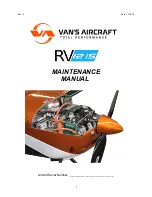
Quik & Quik GT450 Aircraft Operating Instructions
29
th
March 2007
Issue 1
Page 56 of 68
Rotax 912/912S Carburettor Heat System
A carburettor body warming system supplied with heat from the coolant is installed.
The radiator cover should be adjusted to obtain at least 80C coolant temperature for the system to work
effectively. Power reduction due to intake temperature rise is small and the system can be used with carb
heat selected ON continuously. Pipes and connections should be checked regularly for condition/chafing.
See maintenance section.
11.10. SECONDARY STRUCTURES AND SYSTEMS - RADIATOR COVERS
912/912S Oil Radiator Jacket
In accordance with
P&M Service Bulletin No: 0094
, in which it was noted that it was desirable for the oil
temperature on aircraft equipped with the Rotax 912/912S four stroke engines to reach 100
°
C at least once
per flight, P&M now supply a neoprene jacket which may be fitted to the oil radiator when the aircraft is
operated in cool ambient temperature. The purpose of this jacket is:
1. To make it easier to reach 100
°
C in normal use, in order to minimise the risk of humidity building
up in the oil system.
2. To speed up the warm-up procedure.
Note
! If your aircraft regularly reaches 100
°
C in normal operations, there is no need to fit the cover.
Usage
The oil temperature on the 912/912S depends on the use to which it is put. Extended periods at high RPM in
hot climates will result in temperatures of 100
°
+C, whereas at a typical cruise of 4000rpm in an ambient
temperature of 23
°
C or less, 75-85
°
is the normal oil temperature. Whether to use the jacket with 100% or
50% coverage, or indeed at all, becomes a function of how the engine is used and in what ambient
temperatures. The responsibility for ensuring that the oil temperature remains within the correct limits is
therefore the pilot’s. Regular in-flight checks should be made to ensure that the oil temperature remains
within the desired range of 85-100
°
C and that the following limitations are respected:
2. Lower oil limit:
50
°
C
3. Upper oil limit
912 engine: 140
°
C 912S engine: 130
°
C
Adjustment
In the event that 120
°
C is reached in a typical climb to 2000’ or 600m, it is probable that the jacket is
covering too much of the radiator for the prevailing conditions. Make a precautionary landing and
adjust/remove as necessary. To adjust from 100% to 50% coverage, simply pull the bottom of the cover up
to the top.
The following are typical coverage settings in normal usage:
AMBIENT TEMPERATURE
RADIATOR COVERAGE
Up to 23
°
C
100%
24-32
°
C
50%
33
°
C+
No coverage - remove jacket
Inspection
Check the security of the installation of the jacket as part of your daily inspection, and carefully inspect the
jacket for wear or damage every 50 hours.
11.11 TRIM SYSTEM
Electric trimmer
The wing is provided with fixed reflex lines and a small bracket on the wing keel. An electric winch with limit
switches and position sensor is mounted at the bottom of the pylon. The winch is operated by a spring-return
switch on the throttle box and the trim position is displayed by LED bar graph on the instrument panel. The
winch pulls on a bungee inside the pylon fairing which pulls a cord connected via a pulley to the wing keel
bracket. This system provides finger-tip control, with lighter pitch and roll forces at low speeds than the reflex
trimmer. Aerodynamic efficiency is also better at slow speeds.
Normal operation
The basic operation of the trimmer is to set the desired attitude and adjust the power setting so that the
aircraft is in a steady state, and then adjust the trimmer till the bar force disappears. It is
not
good practice to
fight the trimmer by pulling the bar in whilst selecting slow trim.






































